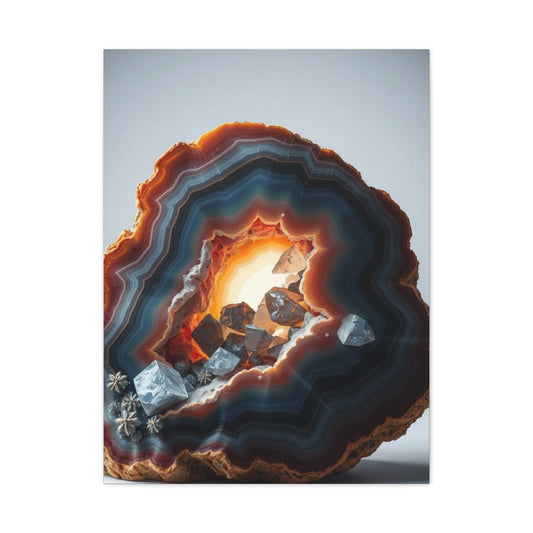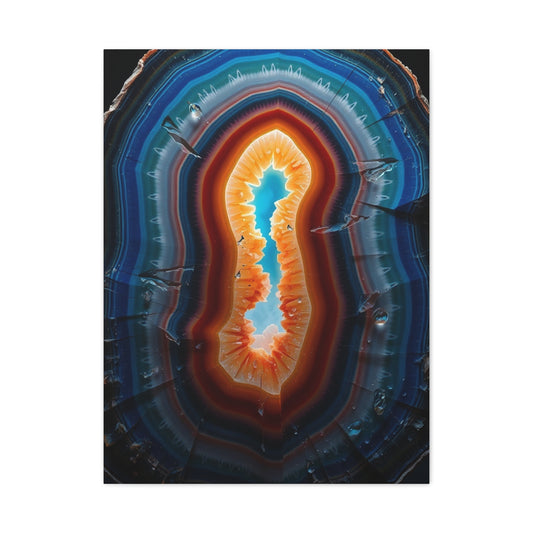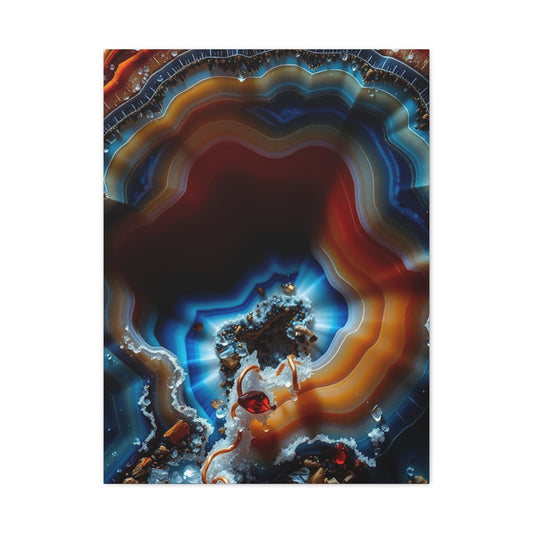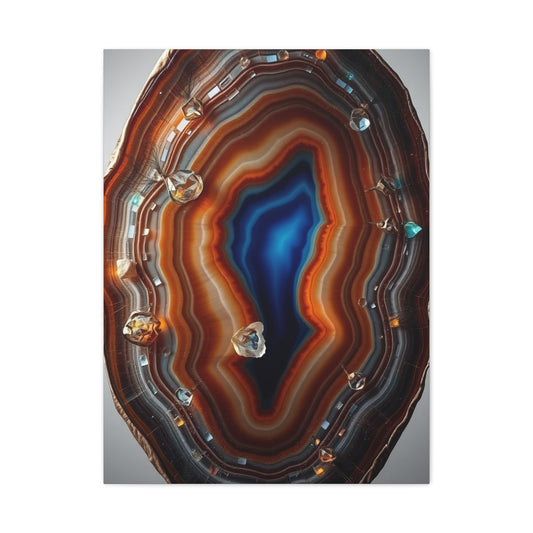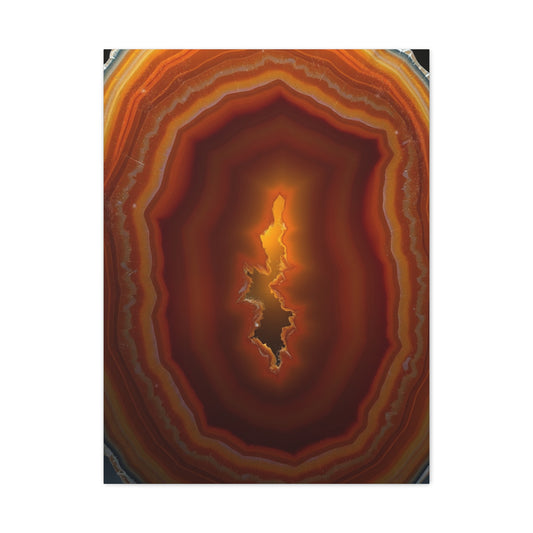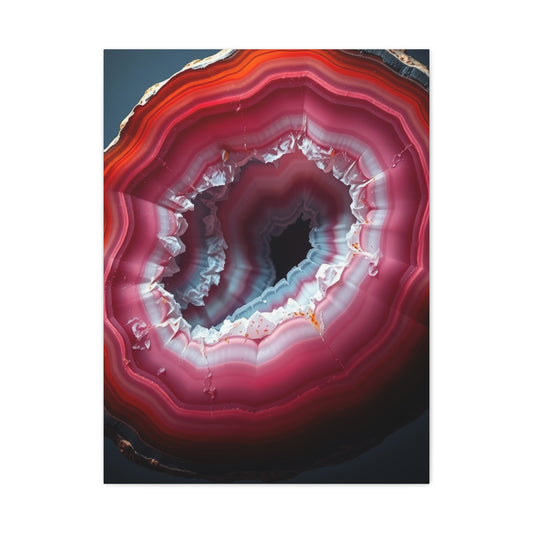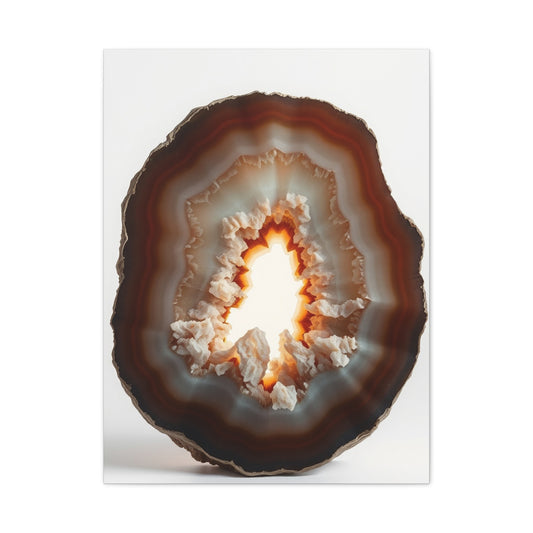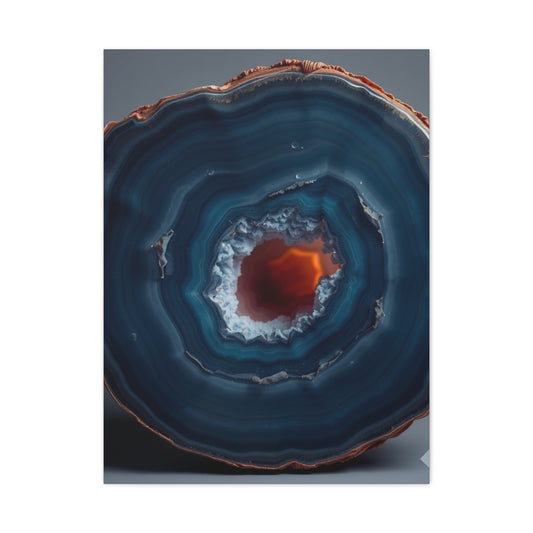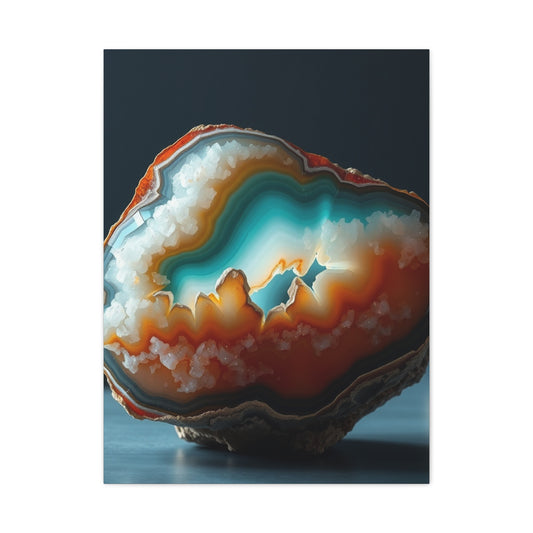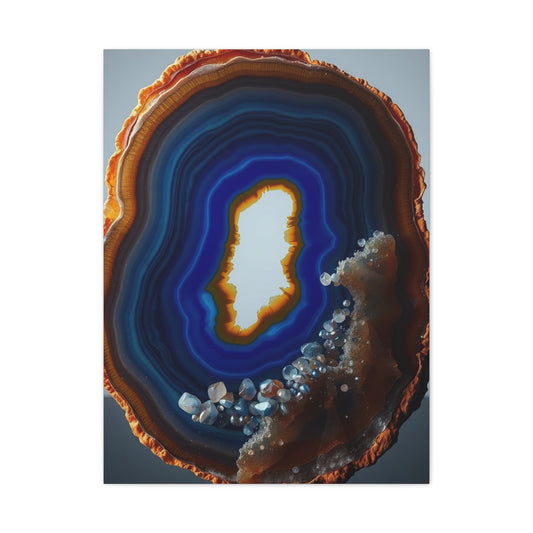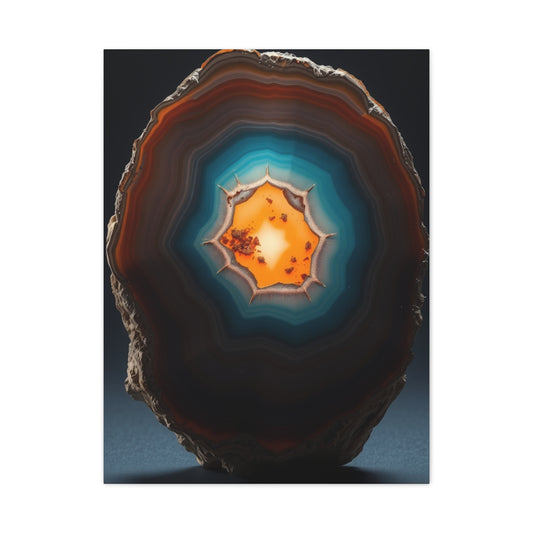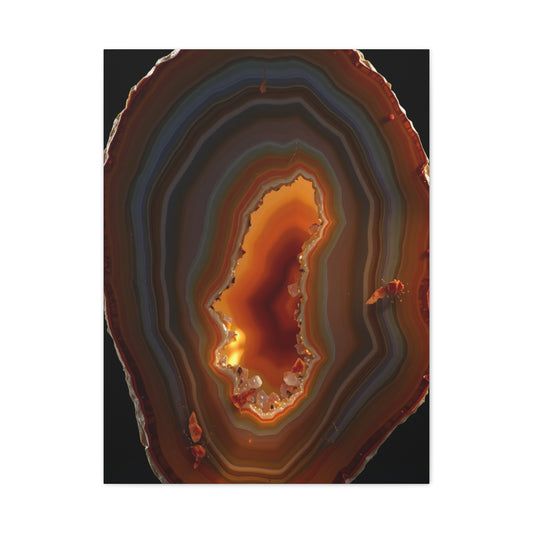Natural Elegance: Agates, Geodes & Mineral-Inspired Wall Art
The mesmerizing allure of agate has captivated interior design enthusiasts worldwide, transforming ordinary living spaces into extraordinary sanctuaries of natural beauty. This crystalline wonder, formed deep within the Earth's crust over millions of years, brings an unparalleled sophistication and organic elegance to modern home decor. The intricate patterns, vibrant hues, and translucent qualities of agate make it one of the most coveted materials for contemporary interior design projects.
Agate represents far more than a simple decorative element; it embodies the raw power and sublime artistry of nature itself. Each piece tells a unique geological story, displaying bands of color that chronicle ancient volcanic activity and mineral deposits. These natural formations create stunning visual narratives that no artificial material can replicate, making agate decor an investment in authenticity and timeless appeal.
The growing fascination with agate decor stems from our collective desire to reconnect with nature while maintaining sophisticated aesthetic standards. In an increasingly digital world, these natural stone elements provide tactile grounding and visual respite from synthetic materials. The organic patterns and earthy tones create harmonious environments that promote tranquility and well-being, making agate an ideal choice for mindful living spaces.
The Geological Marvel Behind Agate Beauty
Understanding the formation process of agate enhances appreciation for its decorative potential. This semiprecious stone develops within volcanic rock cavities, where silica-rich groundwater slowly deposits layers of microscopic quartz crystals over extended periods. The result is a banded chalcedony with extraordinary patterns that range from perfectly concentric circles to wild, abstract swirls reminiscent of modern art masterpieces.
The diversity of agate varieties available for home decor is truly remarkable. Brazilian agates display bold, contrasting bands in dramatic color combinations, while Uruguayan specimens often feature delicate pastel hues that complement minimalist design schemes. Botswana agates showcase subtle earth tones with intricate eye patterns, while crazy lace agates from Mexico present chaotic, energetic designs perfect for eclectic interiors.
The translucent nature of many agate specimens creates captivating light play when strategically positioned near windows or artificial lighting sources. This optical quality transforms static decorative pieces into dynamic focal points that change throughout the day as lighting conditions shift. The interplay between light and stone creates an ever-evolving visual experience that keeps interior spaces feeling fresh and engaging.
Color psychology plays a significant role in agate selection for interior design purposes. Cool blue agates promote serenity and focus, making them ideal for bedrooms and meditation spaces. Warm orange and red varieties energize living areas and social spaces, while neutral gray and white specimens provide sophisticated backdrops that complement any color scheme. Understanding these psychological associations helps homeowners select agate pieces that support their desired atmospheric goals.
Transformative Power of Agate Wall Art
Wall art represents one of the most impactful applications of agate in interior design. Large agate slices, when properly illuminated and mounted, become stunning focal points that command attention while maintaining organic elegance. These natural canvases display millions of years of geological artistry, creating conversation pieces that never lose their visual appeal.
The scale options for agate wall art accommodate various design preferences and spatial requirements. Massive specimen walls create dramatic statements in contemporary homes, while smaller arrangements offer subtle sophistication suitable for traditional settings. The key lies in understanding how agate's natural patterns interact with surrounding architectural elements and furnishings to create cohesive design narratives.
Professional lighting design elevates agate wall art from attractive decor to breathtaking artistic installations. LED backlighting emphasizes the stone's translucent qualities, creating ethereal glows that transform rooms into mystical environments. Strategic spotlighting highlights surface textures and color variations, while ambient lighting integration ensures that agate pieces remain visually engaging during evening hours.
The mounting and presentation of agate wall art requires careful consideration of both aesthetic and practical factors. Custom framing options range from minimalist metal surrounds that emphasize the stone's natural beauty to elaborate wooden frames that complement traditional decor themes. Floating mount systems create modern, gallery-like presentations that allow agate specimens to appear suspended in space.
Color coordination between agate wall art and existing decor elements creates harmonious interior compositions. Complementary color schemes using opposite hues from the agate's natural palette create vibrant, energetic environments, while analogous approaches using similar tones promote tranquil, cohesive atmospheres. Understanding color theory principles helps homeowners maximize the visual impact of their agate installations.
Functional Agate Decor Elements
Beyond pure aesthetic applications, agate serves numerous functional purposes in contemporary home design. Agate bookends combine practical utility with natural beauty, supporting literary collections while adding geological interest to shelving systems. These functional sculptures demonstrate how decorative elements can serve multiple purposes without compromising visual appeal.
Agate coasters and serving accessories bring natural elegance to dining experiences while protecting furniture surfaces from heat and moisture damage. The unique patterns of each piece ensure that no two dining settings appear identical, creating personalized experiences for guests while maintaining consistent design themes throughout entertaining spaces.
Clock designs incorporating agate faces merge timekeeping functionality with artistic expression. The natural banding patterns create dynamic backgrounds for clock mechanisms, transforming mundane timepieces into sculptural elements worthy of prominent display. These functional art pieces demonstrate how everyday objects can become design statements when crafted from exceptional materials.
Lighting fixtures incorporating agate elements create ambient illumination while showcasing the stone's translucent properties. Pendant lights with agate shades cast intricate shadow patterns while diffusing warm, inviting light throughout living spaces. Table lamps featuring agate bases provide task lighting while serving as decorative anchors for room compositions.
Storage solutions utilizing agate elements combine organization with ornamentation. Decorative bowls and vessels crafted from agate provide attractive containers for small items while contributing to overall design schemes. These functional pieces demonstrate how storage needs not compromise aesthetic goals when thoughtfully integrated into interior compositions.
Color Palette Exploration in Agate Decor
The spectacular color range available in natural agate specimens provides endless possibilities for interior design applications. Deep cobalt blues evoke oceanic tranquility and infinite sky expanses, creating calming environments perfect for relaxation and contemplation. These cool tones pair beautifully with crisp whites and warm metallics, establishing sophisticated color schemes that feel both contemporary and timeless.
Vibrant fuchsia and pink agate varieties inject feminine energy and playful sophistication into interior spaces. These warm hues complement gold accents and neutral backgrounds, creating environments that feel both luxurious and approachable. The natural variations in pink agate ensure that each piece contributes unique character while maintaining cohesive color themes.
Earthy brown and amber agates provide grounding elements that connect interior spaces with natural environments. These warm, neutral tones serve as excellent foundation colors for layered design schemes, supporting both bold accent pieces and subtle complementary elements. The organic feel of earth-toned agates makes them particularly suitable for rustic and transitional design styles.
Green agate specimens bring fresh, revitalizing energy to interior compositions while maintaining sophisticated appeal. From pale sage to deep forest green, these natural hues promote harmony and balance while providing excellent backdrops for metallic accents and contrasting color elements. Green agates work particularly well in spaces designed for relaxation and renewal.
Multi-colored agate pieces featuring complex banding patterns offer versatility that accommodates various design approaches. These natural rainbows can anchor eclectic design schemes while providing color inspiration for entire room compositions. The key to successfully incorporating multi-colored agates lies in identifying dominant hues and building complementary palettes around these natural foundations.
Integration Techniques for Modern Interiors
Successfully incorporating agate decor into contemporary living spaces requires understanding how natural stone elements interact with modern materials and design principles. The contrast between organic agate textures and sleek metal surfaces creates dynamic visual tension that energizes minimalist environments while maintaining sophisticated appeal.
Layering techniques using multiple agate pieces of varying sizes and colors create depth and visual interest without overwhelming space compositions. Strategic groupings of three or five pieces follow design principles while allowing individual specimens to maintain their unique characteristics. The key lies in balancing unity and variety to create cohesive yet engaging displays.
Scale consideration becomes crucial when selecting agate pieces for specific interior applications. Large specimens work best as singular focal points in spacious environments, while smaller pieces excel in grouped arrangements or as accent elements within larger compositions. Understanding spatial relationships helps homeowners select appropriately sized pieces that enhance rather than overwhelm their intended locations.
Texture mixing between smooth, polished agate surfaces and rough, natural edges creates tactile interest that invites closer examination. This contrast adds sophistication to interior compositions while highlighting the diverse characteristics available within single specimens. Strategic placement of varied textures throughout spaces creates visual rhythm and movement.
The integration of agate elements with existing furniture and architectural features requires careful consideration of proportion, color, and style compatibility. Modern furniture pieces with clean lines provide excellent backdrops for organic agate forms, while traditional furnishings can be updated and refreshed through strategic agate accents.
Maintenance and Care for Agate Decor
Proper maintenance ensures that agate decor pieces retain their natural beauty and visual impact over time. Regular dusting with soft, dry cloths removes accumulated particles without scratching polished surfaces or damaging delicate edges. Avoiding harsh chemicals and abrasive cleaning products preserves the stone's natural luster and prevents damage to protective sealants.
Environmental factors significantly impact agate longevity and appearance. Extreme temperature fluctuations can cause expansion and contraction that leads to cracking or structural damage. Maintaining stable indoor climates protects valuable agate investments while ensuring continued aesthetic appeal.
Proper handling techniques prevent damage during cleaning, repositioning, or seasonal decorating changes. Supporting agate pieces from underneath rather than grasping edges or projections reduces stress on vulnerable areas. Using padded surfaces and protective materials during transport protects against chips, scratches, and other mechanical damage.
Storage considerations for seasonal or rotating agate displays require attention to cushioning, climate control, and organizational systems. Wrapping individual pieces in soft materials prevents contact damage, while maintaining consistent temperature and humidity levels prevents environmental stress. Proper storage extends the lifespan of agate collections while preserving their investment value.
Professional restoration services can address damage or wear that occurs over time, returning cherished pieces to their original condition. Understanding when to attempt home repairs versus seeking professional assistance protects valuable specimens from additional damage while ensuring appropriate treatment methods.
Creating Focal Points with Statement Pieces
Large agate specimens serve as natural focal points that anchor interior design schemes while showcasing nature's artistic capabilities. These statement pieces require careful positioning to maximize visual impact while maintaining balanced compositions throughout living spaces. Strategic placement near natural light sources emphasizes translucent qualities and color variations.
The relationship between statement agate pieces and surrounding decor elements determines overall composition success. Supporting accessories should complement rather than compete with primary specimens, creating harmonious environments that allow natural beauty to shine. Neutral backgrounds provide excellent canvases for dramatic agate displays.
Lighting design specifically tailored to highlight statement agate pieces transforms them from attractive decor into breathtaking art installations. Professional lighting consultations ensure optimal illumination that emphasizes positive characteristics while minimizing any less attractive features. Custom lighting solutions create dramatic effects that evolve throughout daily lighting cycles.
Seasonal rotation of statement pieces maintains visual freshness while allowing homeowners to enjoy multiple specimens throughout the year. This approach maximizes collection value while preventing visual fatigue that can occur with permanent displays. Storage systems that protect rotated pieces ensure their continued availability for future use.
The psychological impact of statement agate pieces extends beyond visual appeal to influence mood and atmosphere within interior spaces. These natural elements create connections with geological time scales that promote perspective and tranquility. Understanding these effects helps homeowners select pieces that support their lifestyle and wellness goals.
Styling Tips for Maximum Visual Impact
Professional styling techniques maximize the visual impact of agate decor while maintaining sophisticated interior compositions. The rule of odds suggests grouping agate pieces in numbers of three or five creates more dynamic and visually appealing arrangements than even-numbered groupings. This principle applies to both wall displays and tabletop compositions.
Height variation within agate groupings creates visual rhythm and prevents static, monotonous displays. Combining tall, vertical pieces with low, horizontal specimens creates balanced compositions that guide the eye through space while maintaining engagement. Strategic elevation using stands or pedestals enhances this dimensional variety.
Color temperature coordination between agate pieces and surrounding lighting creates cohesive atmospheric effects. Warm lighting enhances orange, red, and yellow agate tones, while cool lighting emphasizes blues, greens, and purples. Understanding these relationships helps create intentional moods within interior spaces.
Negative space utilization prevents overcrowded displays while allowing individual agate pieces to maintain their visual prominence. Adequate spacing between specimens ensures that each piece receives appropriate attention while contributing to overall compositional success. Less is often more when displaying high-quality natural specimens.
Seasonal styling adjustments keep agate displays feeling fresh and current while accommodating changing decor preferences. Summer arrangements might emphasize cool blue and green specimens, while winter displays could feature warm orange and red varieties. These rotational approaches maximize collection versatility.
Budget-Conscious Agate Decorating Strategies
High-impact agate decorating need not require substantial financial investments when approached strategically. Small specimens can create significant visual impact when properly grouped and displayed, offering affordable entry points into agate decorating. These starter collections can be expanded gradually as budgets allow.
Shopping timing affects agate availability and pricing significantly. End-of-season sales, estate sales, and gem and mineral shows often provide excellent opportunities to acquire quality specimens at reduced prices. Patient collectors who wait for optimal purchasing opportunities can build impressive collections economically.
DIY mounting and display solutions reduce professional installation costs while providing personalized customization options. Simple easel stands, shadow boxes, and floating shelves create attractive presentation options without requiring expensive custom work. These approaches allow budget-conscious decorators to achieve professional-looking results.
Strategic placement of affordable agate pieces in high-visibility locations maximizes their visual impact regardless of individual specimen cost. A single well-chosen piece prominently displayed often creates more impact than multiple expensive specimens poorly positioned. Understanding design principles helps optimize limited budgets.
Alternative agate sources including online retailers, rock and mineral clubs, and direct-from-source purchases can provide significant cost savings compared to traditional home decor retailers. Research and patience often reveal excellent specimens at fraction of retail prices.
Complementary Design Elements and Accessories
Metallic accents complement agate decor beautifully, with gold providing warm luxury that enhances earth-toned specimens, while silver offers cool sophistication that pairs well with blue and gray varieties. Copper and bronze provide intermediate options that work well with green and multi-colored pieces. Strategic metallic integration creates cohesive luxury aesthetics.
Textile selections can enhance or detract from agate displays depending on color, texture, and pattern choices. Solid-colored fabrics provide neutral backgrounds that allow agate patterns to dominate visual attention, while subtle patterns can complement natural banding without creating competitive visual noise. Natural fiber textures enhance organic themes.
Plant pairings create living compositions that emphasize the natural origins of agate specimens while adding fresh vitality to interior spaces. Succulents and air plants complement the mineral aesthetic while requiring minimal maintenance. Larger plants can provide scale context for substantial agate displays.
Furniture selection impacts the effectiveness of agate decor integration significantly. Clean-lined modern pieces provide excellent backdrops for organic stone forms, while ornate traditional furniture can overwhelm subtle agate beauty. Understanding these relationships guides successful interior compositions.
Artwork coordination ensures that agate displays work harmoniously within broader interior design schemes rather than competing with other decorative elements. Abstract pieces often complement agate patterns well, while realistic artwork might create visual confusion. Strategic art placement supports overall design goals.
The Rise of Agate in Interior Design: A Blend of Nature and Technology
In recent years, the field of interior design has witnessed a significant shift towards natural, sustainable materials. Among the most captivating of these materials is agate, a mineral known for its vivid color patterns, translucency, and unique geological formations. The increasing focus on sustainability has prompted designers and homeowners alike to explore agate for its timeless appeal and eco-friendly attributes. The trend towards integrating agate in home decor is not just about its natural beauty, but also about its connection to the earth’s geological processes, offering a deeper, more meaningful connection between individuals and their living spaces.
As environmental concerns continue to shape the design world, the popularity of agate has surged, and its role in the creation of sophisticated, luxurious interiors has only expanded. This article delves into the future trends surrounding agate in interior design, discussing its environmental benefits, technological advancements, customization possibilities, and global sourcing opportunities, while highlighting how this remarkable material bridges the gap between nature and modernity.
The Sustainable Appeal of Agate: Natural Elegance for Modern Homes
Sustainability is at the forefront of contemporary interior design, with more people becoming aware of the environmental impact of their choices. Agate, a naturally occurring mineral, stands out as a sustainable option in the world of interior design. Unlike synthetic materials, which often require significant energy consumption during production and contribute to environmental degradation, agate is a product of millions of years of geological processes. It is a material that embodies the earth’s natural rhythms and is formed through volcanic and sedimentary activities, ensuring its eco-friendly nature.
The increasing interest in sustainable design has led to a rising demand for natural stones, and agate is a prime example of this trend. Its ability to withstand the test of time and retain its aesthetic appeal over decades, if not centuries, makes it an investment in lasting beauty. Unlike manufactured materials that may degrade or lose their luster over time, agate’s intrinsic properties allow it to maintain its visual impact for generations, making it a timeless addition to any interior.
Furthermore, agate's minimal processing requirements enhance its appeal to environmentally conscious consumers. While some stones require extensive mining and cutting processes, agate’s natural structure and colors often allow for less alteration, preserving the material's authenticity. This reduced need for processing means that fewer resources are expended in the creation of agate decor, further minimizing the environmental footprint associated with its use.
Agate and Technology: A Perfect Marriage of Natural Beauty and Modern Innovation
Agate’s stunning visual appeal is further enhanced through the integration of advanced technologies. One of the most notable advancements in agate interior design is the incorporation of smart lighting systems. These systems can be programmed to highlight the stone’s translucent qualities at specific times throughout the day, creating a dynamic, ever-changing aesthetic that adapts to the natural lighting conditions of the space.
LED lighting, in particular, has transformed the way agate is showcased. These energy-efficient lights are capable of illuminating the stone from behind, allowing light to pass through its layers, bringing out the intricate patterns and vibrant colors that define agate. The ability to control the color temperature of LED lights offers even greater customization, enabling designers to adjust the lighting to enhance different hues in the stone. Whether the goal is to create a warm, inviting atmosphere or a cool, calming ambiance, smart lighting systems can tailor the experience of agate in a space.
Moreover, advancements in LED technology ensure that these lighting solutions are not only effective but also environmentally friendly. The energy efficiency of LED lights significantly reduces power consumption compared to traditional lighting methods, making them an ideal choice for those seeking to incorporate sustainability into their design without sacrificing style.
The Rise of Customization in Agate Design: Tailored to Personal Aesthetics
As more homeowners and designers seek unique and personalized interiors, the demand for custom agate installations has risen. Today, it is possible to commission one-of-a-kind agate pieces that meet specific spatial and aesthetic requirements. This level of customization allows agate to be used in a variety of applications, from large statement pieces to subtle accents that enhance a room’s overall atmosphere.
Professional designers often collaborate with geological suppliers to source agate specimens that match the desired specifications, including color, size, and pattern. The customization process may involve choosing agate slices with particular characteristics, such as striking banding patterns, vibrant color contrasts, or unusual inclusions. By working closely with suppliers, designers can create bespoke installations that reflect the homeowner’s individual style and the unique characteristics of the space.
This trend towards personalization has opened up new possibilities for integrating agate into various interior design styles. Whether incorporated into contemporary, rustic, or eclectic designs, agate offers endless creative potential. Designers can use agate as a central focal point in a room, whether in the form of wall panels, countertops, or backsplashes, or as a delicate touch through smaller accent pieces like coasters, trays, or lighting fixtures.
The Art of Mixing Materials: Agate as Part of a Hybrid Design Approach
While agate alone makes a bold statement, it also works exceptionally well when combined with other materials. The trend towards mixed media in interior design has introduced new creative possibilities, blending the organic beauty of agate with other natural materials such as wood, metal, and glass. This approach allows designers to craft sophisticated, multi-layered installations that highlight the textural contrasts between agate’s smooth, polished surface and the rough, organic feel of wood or the sleek, modern lines of metal.
For example, agate slices can be framed with brushed metal or mounted on wooden panels, creating a beautiful juxtaposition between the earthy and the industrial. The use of glass alongside agate allows for further light play, amplifying the stone’s inherent translucency and creating a sense of depth and movement within the space. These hybrid installations not only showcase the beauty of agate but also contribute to the overall aesthetic diversity of the room, adding depth and texture through the thoughtful combination of different elements.
Furthermore, this blending of materials allows for the creation of multi-functional pieces that serve both decorative and practical purposes. For instance, agate-topped coffee tables, with their mix of stone and wood, become both a statement piece and a functional surface, while agate inlay designs in furniture offer a glimpse of the natural world within the confines of modern, industrial decor.
Expanding Global Sourcing: Access to Agate from Around the World
In the past, agate was primarily sourced from a few well-known regions, such as Brazil, Mexico, and the United States. However, with the increasing popularity of agate in interior design, global sourcing has expanded, allowing for a wider variety of agate types to enter the market. This has led to the discovery of unique color combinations, patterns, and textures that were once unavailable, offering designers more options to work with in their projects.
Agate is now sourced from regions around the world, including India, Madagascar, and even remote parts of Africa. Each location offers a distinct range of colors and patterns, from the deep blues and greens of agate found in Madagascar to the warm, earthy tones of agate from India. The availability of these diverse varieties enables designers to incorporate agate in a broader range of design schemes, ensuring that the stone can complement virtually any aesthetic, from minimalistic and neutral to bold and vibrant.
In addition to enhancing the creative possibilities of agate in interior design, the global sourcing of this material has also contributed to the growth of a more sustainable agate industry. With the increased demand for ethically sourced agate, suppliers are now more conscious of the environmental impact of their operations, ensuring that the mining and processing of agate are done in a responsible manner.
Agate: A Timeless Connection to the Earth’s Geological Legacy
Agate, a captivating gemstone renowned for its striking appearance, holds a profound connection to the Earth's deep geological history. For centuries, this natural stone has been admired for its intricate patterns and vivid colors, which are the result of millions of years of volcanic and sedimentary activity. Every piece of agate tells a unique story that transcends time, reflecting the forces of nature that shaped it. As a symbol of stability, endurance, and balance, agate serves as a reminder of the Earth's natural beauty, providing a tactile and visual link to the environment around us.
While many people choose agate simply for its aesthetic appeal, it is the stone's deeper significance that makes it such a valuable addition to interior spaces. Beyond its role as an elegant decor element, agate represents a connection to the past, a symbol of the Earth's ongoing transformation, and a celebration of the natural world’s ability to create beauty through millennia. Agate’s appeal has only grown in recent years, with a surge in demand for sustainable, timeless materials that reflect a growing consciousness about the environment.
The Geological Significance of Agate: Shaped by Time and Forces of Nature
At its core, agate is a product of the Earth’s intricate geological processes. This stone forms through a long and complex series of events, beginning with the cooling and solidification of volcanic rock. Over time, water and mineral-rich solutions seep into cavities in the rock, where they gradually deposit layers of minerals, creating the colorful, banded patterns that are characteristic of agate. These mineral deposits, formed over millions of years, give each piece its unique design, ensuring that no two agates are ever the same.
The beauty of agate lies in its layers, which tell the story of the forces that shaped it. The layers vary in color, texture, and transparency, creating a sense of depth and complexity that can be mesmerizing to the viewer. Agate’s unique color combinations, which range from rich blues and greens to warm oranges, browns, and reds, reflect the mineral composition of the surrounding environment, adding to the stone’s intrinsic link to the natural world.
For many people, this connection to the Earth’s geological past is one of the most compelling reasons to incorporate agate into their homes. The stone becomes a tangible reminder of the power and resilience of the natural world, offering a sense of calm and grounding. It evokes an understanding of the Earth’s long and slow process of transformation, giving those who appreciate it a deeper connection to the natural world.
Agate in Interior Design: Beyond Mere Decoration
Incorporating agate into home decor is about more than just enhancing the aesthetics of a space; it is a way of cultivating an environment that reflects a deep respect for nature and the Earth's timeless beauty. As sustainable design continues to dominate the modern interior landscape, homeowners and designers alike have turned to agate for its ability to provide both visual and emotional richness to their living spaces.
Agate is used in a wide variety of applications within interior design, from statement pieces that serve as the focal point of a room to subtle accents that complement other elements of the decor. Whether showcased as wall art, used in furniture design, or incorporated into countertops and backsplashes, agate brings a sense of nature’s artistry into the home. Its versatility makes it suitable for a range of design styles, from rustic and earthy to sleek and modern.
One of the most compelling reasons to use agate in interior design is its timeless quality. Unlike trends that come and go, agate's natural beauty endures. Its appeal lies in its ability to transcend passing fads, offering an enduring connection to the Earth. As such, incorporating agate into your home is not just an aesthetic choice but an investment in a material that will stand the test of time, both in terms of its appearance and its significance.
Agate as a Symbol of Stability and Balance
Agate has long been considered a symbol of stability, strength, and balance. Its layered structure, which is formed over countless years, represents the enduring nature of the Earth itself. In interior design, agate is often used to bring a sense of harmony and tranquility to a space. The stone’s calming colors and intricate patterns help create an environment that promotes relaxation, making it an ideal choice for spaces designed for meditation, rest, or contemplation.
In a living room, for example, agate can be used as a statement piece, drawing attention to its natural beauty while creating a sense of balance and order within the space. Agate’s grounding qualities can also be incorporated into more intimate areas of the home, such as bedrooms or home offices, where a peaceful atmosphere is desired. Its serene, natural appearance helps foster an environment that encourages focus, relaxation, and mindfulness, turning your home into a sanctuary from the stresses of daily life.
Moreover, the symbolic importance of agate is not confined to its visual properties. The stone’s ability to embody stability and balance is particularly resonant in an age where many people are seeking to reconnect with nature and create living spaces that reflect their values. The use of agate in home decor can be seen as a conscious decision to incorporate natural elements into one's environment, fostering a sense of calm and well-being in both the individual and the space.
Agate’s Role in Modern Design Trends: Sustainability and Personalization
As sustainability becomes increasingly important to consumers, the demand for natural, eco-friendly materials like agate has risen sharply. Agate, being a naturally occurring stone with minimal processing, fits perfectly within this ethos, offering a sustainable alternative to synthetic materials that often require significant energy to produce. Unlike many artificial materials, agate’s production process does not harm the environment, making it a responsible choice for conscientious homeowners and designers.
Additionally, agate’s durability and timeless beauty make it a material that can be cherished for years to come, reducing the need for frequent replacements and contributing to a more sustainable lifestyle. As people become more aware of the environmental impact of their purchasing decisions, the appeal of agate grows, aligning with the broader trend towards sustainability in interior design.
Another factor driving the popularity of agate in modern design is its customization potential. Agate comes in an array of colors, patterns, and textures, allowing homeowners and designers to choose pieces that perfectly align with their personal tastes and design preferences. Custom agate pieces can be tailored to fit specific spaces, ensuring that each piece is not only unique but also complementary to the existing decor.
Agate’s versatility allows it to blend seamlessly with a variety of other materials, from wood and metal to glass and concrete. Whether paired with sleek modern finishes or rustic, organic textures, agate enhances the overall design, adding depth and interest to any space. This adaptability makes it a favorite among designers who value both aesthetic flexibility and the timeless appeal of natural materials.
The Future of Agate in Interior Design: A Lasting Legacy
As we look to the future of interior design, it’s clear that agate will continue to play an important role in shaping the spaces we live in. Its rich history, geological significance, and unique beauty ensure that it will remain a sought-after material in both residential and commercial interiors. The growing demand for sustainable, eco-friendly materials, combined with advances in technology and customization options, ensures that agate will remain relevant in design trends for years to come.
One area in which agate’s popularity is expected to grow is in high-end, bespoke design projects. As more people seek to create personalized, one-of-a-kind spaces that reflect their unique tastes and values, the demand for custom agate installations will rise. From custom-cut countertops and backsplashes to large-scale statement art pieces, agate offers unparalleled flexibility for designers looking to create luxurious, nature-inspired interiors.
The future of agate in interior design will also likely see the continued integration of technology. LED lighting, for example, is increasingly being used to highlight agate’s translucent qualities, allowing its natural beauty to be enhanced in dynamic ways. As lighting technology continues to evolve, new ways of showcasing agate’s intricate patterns and colors will emerge, further solidifying its place in modern design.
Moreover, the global sourcing of agate is expected to expand, giving designers access to an even wider variety of colors and patterns. As international suppliers continue to find new ways to ethically source and process agate, the material will become more accessible and versatile, allowing for greater experimentation in design.
Conclusion
The enduring charm of agate lies not only in its striking visual appeal but also in the deeper sense of connection it fosters with the natural world. At a time when daily life often feels fast-paced, digital, and disconnected from nature, agate reminds us of the Earth’s quiet but powerful rhythms. This gemstone, formed over millions of years through slow geological processes, embodies patience, resilience, and timeless beauty. Its very presence carries the story of transformation—how pressure, time, and natural elements can come together to create something both strong and breathtaking.
When agate finds its way into the home, it becomes more than just a decorative object. It offers an invitation to pause, reflect, and appreciate the magnificence of nature’s artistry. Its smooth textures, captivating colors, and layered patterns bring a grounding quality that encourages mindfulness and presence. Unlike artificial materials that often lack depth, agate resonates with authenticity and meaning. It serves as a daily reminder that beauty is not rushed but cultivated over time, much like the stone itself.
In interior design, agate seamlessly blends functionality with emotional impact. Whether placed in a living room as a centerpiece, displayed in a bedroom for a calming effect, or incorporated into an office as a subtle accent, agate has the ability to transform ordinary spaces into sanctuaries of balance and tranquility. Its natural variations ensure that no two pieces are alike, giving every installation a sense of individuality and exclusivity. This uniqueness makes agate not just a design choice, but a personal statement—an expression of harmony with the Earth.
Beyond its aesthetic contribution, agate also aligns with values that are becoming increasingly central in modern lifestyles: sustainability, mindfulness, and the pursuit of meaningful living. Unlike mass-produced décor that often loses significance over time, agate has an enduring relevance that transcends passing design trends. It reflects our growing awareness of the importance of choosing materials that respect the Earth’s resources while enhancing the quality of our living spaces.
Historically, agate has been cherished across cultures for its symbolic associations with protection, healing, and balance. By incorporating agate into contemporary interiors, we are not only appreciating its visual beauty but also continuing an age-old tradition of honoring stones for their deeper resonance. Each piece becomes a bridge between past and present, linking ancient practices with modern sensibilities. This historical richness adds yet another layer of depth to its presence in the home.
Perhaps what makes agate most extraordinary is its dual nature: it is both grounding and inspiring. On one hand, it roots us in the reality of the Earth, reminding us of the slow, steady processes that shaped it. On the other hand, its intricate patterns and luminous qualities spark creativity and wonder, encouraging us to dream beyond the ordinary. This balance between stillness and imagination makes agate a perfect companion for spaces where we seek both rest and inspiration.
In the broader picture of interior design, agate serves as a timeless symbol of our connection to nature. Its role is not limited to decoration; it is about creating an environment that nurtures the soul as much as the senses. When carefully chosen and thoughtfully placed, agate becomes a part of the story of a home, shaping how we experience our surroundings and influencing the atmosphere we share with others.
As our world increasingly values sustainability, well-being, and authenticity, agate’s significance in design will only continue to grow. Its ability to marry natural beauty with lasting meaning ensures that it will remain cherished for generations to come. Whether displayed as a bold statement piece, integrated into subtle details, or customized into unique designs, agate consistently adds layers of depth, elegance, and mindfulness to interiors.
Ultimately, incorporating agate into your home is more than a design decision—it is a conscious choice to embrace nature’s wisdom, patience, and creativity. In doing so, you create a living space that is visually captivating and emotionally enriching, a space that reflects not only personal style but also a deeper appreciation for the Earth itself. Agate is, and will continue to be, a timeless reminder that true beauty emerges not from speed or abundance, but from patience, balance, and a profound connection to the natural world.

